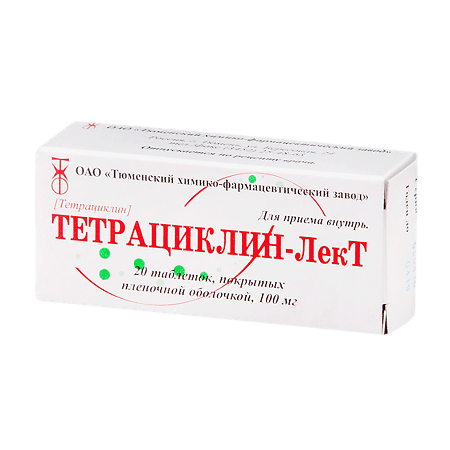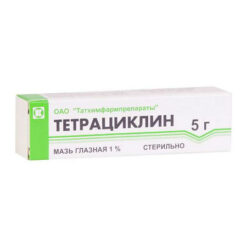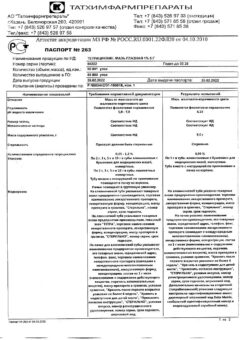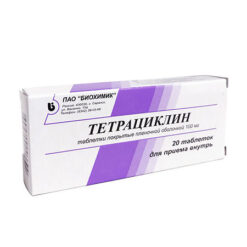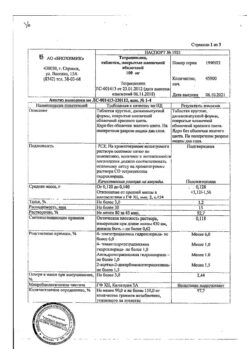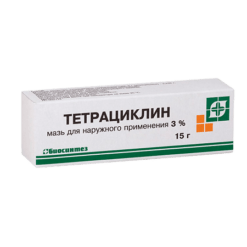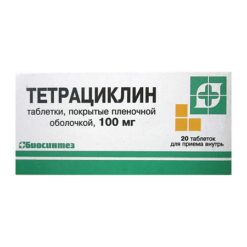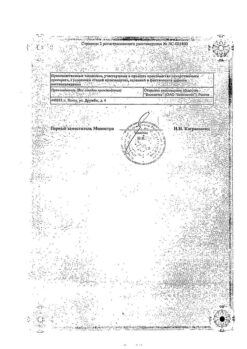No products in the cart.
Tetracycline-LekT, 100 mg 20 pcs
€5.14 €4.57
Description
Pharmacotropic group: antibiotic, tetracycline.
ATX code: [J01AA07].
Pharmacokinetics
Absorption – 75-77%, decreases with food, plasma protein binding – 55-65%.
The time to reach maximum concentration when taken orally is 2-3 hours (it may take 2-3 days to reach therapeutic concentration). Over the next 8 hours the concentration gradually decreases. Maximum concentration is 1.5-3.5 mg/l (a concentration of 1 mg/l is sufficient to achieve therapeutic effect).
In the body it is distributed unevenly: the maximum concentration is contained in the liver, kidneys, lungs and in organs with a well developed reticuloendothelial system – spleen, lymph nodes. The concentration in bile is 5-10 times higher than in blood serum. In thyroid and prostate tissues tetracycline content is the same as in plasma; in pleural, ascitic fluid, saliva, milk of lactating women – 60-100% concentration in plasma.
It is slightly metabolized in the liver. The elimination half-life is 6-11 hours; in anuria it is 57-108 hours. It is detected in high concentration in urine within 2 hours after intake and retained for 6-12 hours; during the first 12 hours up to 10-20% of dose is excreted by kidneys. Smaller amounts (5-10% of the total dose) are excreted with bile in the intestine, where it is partially reabsorbed, which allows for prolonged circulation of the active substance in the body (intestine-hepatic circulation). Excretion through the intestine is 20-50%. With hemodialysis it is removed slowly.
Pharmacodynamics
Bacteriostatic antibiotic of tetracycline group. It disrupts formation of the complex between transport RNA and ribosome, which leads to suppression of protein synthesis.
Active against Gram-positive microorganisms – Staphylococcus spp. (including Staphylococcus aureus, including penicillinase-producing strains), Streptococcus spp. (some strains, including Streptococcus pneumoniae), Listeria monocytogenes, Bacillus anthracis, Clostridium spp, Actinomyces spp., Propionibacterium acnes, Bacillus fusiformis;
Gram-negative microorganisms – Haemophilus influenzae, Haemophilus ducreyi, Bordetella pertussis, Escherichia coli, Enterobacter spp. (including Enterobacter aerogenes), Klebsiella spp, Neisseria gonorrhoeae, Shigella spp, Yersinia pestis, Bartonella bacilliformis, Vibrio cholerae, Vibrio fetus, Rickettsia prowazekii, Rickettsia rickettsii, Rickettsia akari, Borrelia Vinceni, Borrelia recurrentis, Borrelia burgdorferi, Brucella spp. (in combination with streptomycin); Calymmatobacterium granulomatis, Francisella tularensis, Treponema pallidum, Treponema pertenue;
In case of contraindications to the administration of penicillins – Clostridium spp, Neisseria gonorrhoeae, Actinomyces spp;
Active against Chlamydia trachomatis; Chlamydia psittaci, Entamoeba histolytica;
Tetracycline-resistant microorganisms: Pseudomonas aeruginosa, Proteus spp; Serratia spp, most strains of Bacteroides spp. and fungi, viruses, group A beta-haemolytic streptococci (including 44% of Streptococcus pyogenes strains and 74% of Streptococcus faecalis strains).
Indications
Indications
Infectious and inflammatory diseases caused by microorganisms sensitive to tetracycline, including.including pneumonia, bronchitis, pleural empyema, angina, cholecystitis, pyelonephritis, intestinal infections, endocarditis, endometritis, prostatitis, syphilis, gonorrhea, brucellosis, rickettsiosis, purulent soft tissue infections, osteomyelitis; trachoma, conjunctivitis, blepharitis; acne.
Prevention of postoperative infections.
Active ingredient
Active ingredient
Composition
Composition
One tablet contains:
The active ingredient:
Tetracycline hydrochloride (in terms of the active ingredient) – 100.00 mg.
Excipients:
Saccharose (white sugar), calcium stearate, talc, gelatin, potato starch.
The film coating:
Hypromellose (oxypropyl methylcellulose), lactose monohydrate (milk sugar), polysorbate 80 (tween-80), dye azorubin (acid red 2C, carmoisin).
How to take, the dosage
How to take, the dosage
In adults, 250-500 mg every 6 hours. Children over 8 years of age – 25-50 mg/kg every 6 hours.
Applied externally several times a day, if necessary apply a light dressing.
Topically 3-5 times a day.
The maximum daily dose for adults when taken orally is 4 g.
Interaction
Interaction
Drugs containing metal ions (antacids, preparations containing iron, magnesium, calcium) form inactive chelates with tetracycline, in connection with this it is necessary to avoid their simultaneous administration.
The combination with penicillins, cephalosporins that have bactericidal effect and are antagonists of bacteriostatic antibiotics (including tetracycline) should be avoided.
The simultaneous use of tetracycline with retinol may lead to intracranial hypertension.
In concomitant use with colestiramine or colestipol impaired absorption of tetracycline is noted.
Special Instructions
Special Instructions
In long-term use it is necessary to periodically monitor the functions of the kidneys, liver, hematopoiesis organs.
The use of tetracycline in children during the period of dental development may lead to irreversible discoloration.
B and K vitamins and brewer’s yeast should be used during treatment to prevent hypovitaminosis.
Tetracycline should not be taken at the same time with milk and other dairy products, since this impairs absorption of the antibiotic.
Contraindications
Contraindications
Side effects
Side effects
Digestive system disorders: nausea, vomiting, anorexia, abdominal pain, diarrhea, constipation, dry mouth, glossitis, discoloration of the tongue, esophagitis, transient increase in liver transaminases, ALP, bilirubin concentration, residual nitrogen.
CNS disorders: dizziness, headache.
Hematopoietic system disorders: neutropenia, thrombocytopenia, hemolytic anemia.
Allergic reactions: skin rash, itching, eosinophilia, Quincke’s edema.
Dermatological reactions: photosensitization.
The effects caused by chemotherapeutic action: candida stomatitis, candida vulvovaginitis, intestinal dysbacteriosis.
Local reactions: soreness at the injection site.
Others: hypovitaminosis of B vitamins.
Pregnancy use
Pregnancy use
Contraindicated in pregnancy (tetracyclines pass through the placenta, accumulate in the bones and dental buds of the fetus, disturbing their mineralization, can cause severe disorders of bone development).
The FDA fetal category is D.
Breast-feeding must be stopped for the duration of treatment (tetracyclines penetrate into the breast milk and can have adverse effects on the development of baby’s bones and teeth, and cause photosensitization reactions and oral and vaginal candidiasis in babies).
Similarities
Similarities
Additional information
| Weight | 0.100 kg |
|---|---|
| Shelf life | 3 years. Do not use after the expiration date printed on the package. |
| Conditions of storage | At a temperature not exceeding 25 ° C. Store out of the reach of children. |
| Manufacturer | Tyumen Chemical Plant, Russia |
| Medication form | pills |
| Brand | Tyumen Chemical Plant |
Other forms…
Related products
Buy Tetracycline-LekT, 100 mg 20 pcs with delivery to USA, UK, Europe and over 120 other countries.

